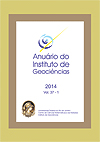Soil erosion and conservation in Brazil
DOI:
https://doi.org/10.11137/2014_1_81_91Abstract
Brazil covers 8,547,403 km² and is divided into five regions (Northern, North Western, Central Western, South Eastern and Southern). The diversity of climate, geology, topography, biota and human activities have contributed to the considerable diversity of soil types and thus soil erosion problems. National soils can be classified into 12 classes. These are: Oxisols (38.7%), Alfisols (20.0%), Inceptisols (2.7%), Mollisols (0.5%), Spodosols (1.6%), Gleysols (3.7%), Aridisols (2.7%), Entisols (14.5%), Vertisols (2.0%), Ultisols (1.8%), Plinthosols (6%) and Alisols (4.3%). The erodibility of these Soil Orders is reviewed and is mainly related to soil texture. Sands and loamy sands are especially erodible. Soil erosion patterns are complex, being influenced by rainfall erosivity, soil erodibility, topography, land use and management characteristics. Urban areas have specific erosion problems and there are illustrated using a case study from São Luis (north-east Brazil). Soil erosion rates can be excessive, in some cases exceeding 100 tonnes per hectare per year. Particularly serious soil erosion is associated with six regions. These are north-western Paraná State; the Central Plateau, in the Centre Western Region; Western São Paulo State; the Paraíba do Sul middle drainage basin, in Rio de Janeiro State; Campanha Gaúcha in Rio Grande do Sul State and Triângulo Mineiro, in western Minas Gerais State. Examples of effective soil conservation are presented, using case studies from both Paraná and Santa Catarina States. Integrated management of drainage basins offers a promising way forward for effective soil conservation in Brazil.Downloads
Download data is not yet available.
Downloads
Published
2014-06-01
How to Cite
Guerra, A. J. T. (2014) “Soil erosion and conservation in Brazil”, Anuário do Instituto de Geociências. Rio de Janeiro, BR, 37(1), pp. 81–91. doi: 10.11137/2014_1_81_91.
Issue
Section
não definida
License
This journal is licensed under a Creative Commons — Attribution 4.0 International — CC BY 4.0, which permits use, distribution and reproduction in any medium, provided the original work is properly cited.















